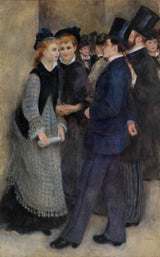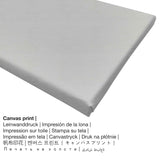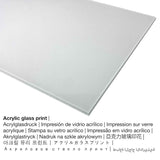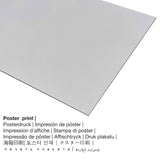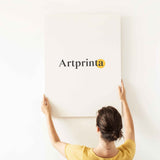Pierre-Auguste Renoir - Leaving the Conservatory (Conservatoire The Exit) - fine art print
Tax included. Shipping calculated at checkout.
What does the original artwork description of the Barnes Foundation say about the work of art from the illustrator, painter and sculptor Pierre-Auguste Renoir? (© - by Barnes Foundation - www.barnesfoundation.org)
A close-packed group of men and women is gathered outside a building, their figures set off against its blank, unadorned, windowless walls. In the foreground, two young men engage two of the women in conversation; the women stand arm in arm, and the hand of the further man rests on his nearer companion's shoulder. We have no clue to the content of the figures' interchange, but their body language suggests some uncertainty or awkwardness, as if the men are engaging the women's attention for the first time. The front man's right hand is clasped behind him, as if he is hesitant or anxious as he steps forward to speak to the women, while the nearer woman turns toward him as if in response to his approach. The further woman, her hands tightly clasped together, turns toward her companion as if to gauge her response to the man's overtures. The nature of the interchange is further obscured by the fact that the second, taller man's face is hidden by his companion's hat, denying us any access to his expression. The foreground man wears a fashionable lounge suit, while his companion is in formal evening dress; the women are simply clad, the nearer one wearing a jerkin over a princess-line dress and an underskirt.The first known title of the canvas, Leaving the Conservatory, derives from the auction sale catalogue of the collection of its first owner, the composer Emmanuel Chabrier, in 1896. The title is confirmed by Renoir's friend Georges Riviere, who seems to have posed for the foreground male figure, since it closely resembles a contemporary portrait of him (National Gallery of Art, Washington, D.C.). The Conservatoire de Musique et de Declamation was situated in the ninth arrondissement of Paris, to the north of the Grands Boulevards, at the junction of rue dli Consrvatoire and rue Sainte-Cecile (the buildings are now occupied by the Conservatoire d'Art Dramatique, after its separation from the Conservatoire de Musique in 1946); it offered free courses in instrumental and vocal music and "dramatic declamation", including evening courses in "popular song" for adults.However, Riviere's account of the picture shows that it cannot be viewed as a straightforward depiction of the site of the Conservatoire, since he specified that Renoir had painted it in front of the house on rue Cortot in Montmartre, which he had rented, in the autumn of 1876, after completing his Ball at the Moulin de la Galette. Moreover, Riviere noted that "Nini and certain habituees of the Moulin" had posed for it. It is thus a wholly imaginative composition, rather than a representation of a specific scenario. Only the rolled paper in the hands of the foreground figure, which could be music or a dramatic text, hints at the Conservatoire, and we must assume that Nini and her friends were employed by Renoir as paid models, rather than themselves being students at the Conservatoire. Viewed in these terms, the picture becomes a more generic image of contemporary courtship rituals, and more specifically of the long-established stereotype of flirtation between young bourgeois men and the lower-class girls who were far more likely to become their mistresses than their wives. Yet the viewer is given no clue to the outcome of the interchange between the figures. Characteristically, Renoir set up the scenario without indicating the precise relationships between the figures or how they might evolve. The viewer of the picture is set a little apart from the figures, watching them from the side and perhaps coming upon them in passing; we are clearly not an immediate part of the group depicted. What we see opens out a set of possibilities; by denying us the resolution of these potential stories, Renoir highlighted the nature of everyday experience in the modern city, where the passer-by witnesses many interchanges and meetings without gaining access to their significance or their outcome. The whole picture is carefully but informally arranged to suggest a slice of city life.The tonality of the picture is relatively subdued, perhaps suggestive of evening light. Yet its dominantly gray tonality is conveyed throughout by delicate variegations of color; soft blues are set off against traces of warm hues, revolving around the pink flesh accents, the orange-red hair of the two young women on the left, and the figures' white collars. Pure black is, it seems, not used; by this date, Renoir had abandoned black in his search to convey form and atmosphere through contrasts and modulations of color. The edges of the figures are not sharply delineated, so that they appear to merge with each other and with the background.Although Leaving the Conservatory is one of the largest and most ambitious of Renoir's canvases of modern Parisian life, it was not, it seems, included in any exhibitions during Renoir's lifetime; it is especially notable that he did not include it in the third impressionist group exhibition in spring 1877, and it is possible that the picture had not been completed by this date.Nor do we know when Chabrier acquired it, or whether it was a commission or a purchase; the composer's interest in the picture must in part have related to its subject-a complement to the noisy world of popular entertainment represented in Manet's A Bar at the Folies-Bergere (Courtauld Gallery, London), which Chabrier bought at Manet's posthumous sale in 1884. John House, Renoir in the Barnes Foundation (New Haven: Yale University Press, 2012), 89.
Structured artwork details
| Work of art title: | "Leaving the Conservatory (Conservatoire The Exit)" |
| Classification of the artwork: | painting |
| Painted on: | oil on canvas |
| Size of the original artpiece: | Overall: 73 13/16 x 46 1/4 in (187,5 x 117,5 cm) |
| Exhibited in: | Barnes Foundation |
| Place of museum: | Philadelphia, Pennsylvania, United States of America |
| Web URL: | www.barnesfoundation.org |
| License type: | public domain |
| Courtesy of: | Courtesy of the Barnes Foundation, Merion and Philadelphia, Pennsylvania |
Artist metadata table
| Artist: | Pierre-Auguste Renoir |
| Other artist names: | a. renoir, pierre august renoir, Auguste Renoir, Renoir August, renoir p.a., Renoir Auguste, Renoir, Renoir Pierre-Auguste, Renoar Pjer-Ogist, firmin auguste renoir, Renoir Pierre August, רנואר פייר אוגוסט, renoir a., Pierre-Auguste Renoir, Pierre Auguste Renoir, Renuar Ogi︠u︡st, Renoir Pierre Auguste, August Renoir, p.a. renoir, רנואר אוגוסט |
| Gender: | male |
| Artist nationality: | French |
| Jobs of the artist: | illustrator, sculptor, painter |
| Country of origin: | France |
| Art styles: | Impressionism |
| Life span: | 78 years |
| Year of birth: | 1841 |
| Town of birth: | Limoges, Nouvelle-Aquitaine, France |
| Died in the year: | 1919 |
| Died in (place): | Cagnes-sur-Mer, Provence-Alpes-Cote d'Azur, France |
Structured product details
| Product classification: | fine art print |
| Method of reproduction: | digital reproduction |
| Manufacturing method: | digital printing |
| Production: | manufactured in Germany |
| Type of stock: | on demand production |
| Intended product use: | wall gallery, gallery wall |
| Orientation: | portrait format |
| Side ratio: | 2 : 3 |
| Meaning of the image ratio: | the length is 33% shorter than the width |
| Materials available: | canvas print, poster print (canvas paper), acrylic glass print (with real glass coating), metal print (aluminium dibond) |
| Canvas on stretcher frame (canvas print) size options: | 20x30cm - 8x12", 40x60cm - 16x24", 60x90cm - 24x35", 80x120cm - 31x47", 100x150cm - 39x59" |
| Acrylic glass print (with real glass coating) options: | 20x30cm - 8x12", 40x60cm - 16x24", 60x90cm - 24x35", 80x120cm - 31x47" |
| Poster print (canvas paper): | 40x60cm - 16x24", 60x90cm - 24x35", 80x120cm - 31x47" |
| Aluminium dibond print (aluminium material) size options: | 20x30cm - 8x12", 40x60cm - 16x24", 60x90cm - 24x35", 80x120cm - 31x47" |
| Frame: | not available |
Pick your material
For every fine art print we offer a range of different materials & sizes. You can choose your favorite size and material among the following preferences:
- The canvas print: The canvas print, not to be confused with a real painting on a canvas, is an image applied directly on canvas fabric. The great advantage of canvas prints is that they are relatively low in weight, which means that it is easy and straightforward to hang up your Canvas print without additional wall-mounts. Because of thata canvas print is suited for all kinds of walls.
- Metal (aluminium dibond print): This is a metal print manufactured on aluminium dibond material with a true depth effect, which makes a modern look thanks to a surface structure, which is non-reflective. For our Direct Print On Aluminum Dibond, we print your chosen artpiece onto the aluminium composite surface. Colors are luminous and vivid, the details are clear and crisp, and there’s a matte appearance you can literally feel.
- Printed poster (canvas material): A poster is a printed cotton canvas paper with a slight surface finish. It is perfectly suited for placing your art print with the help of a customized frame. Please note, that depending on the absolute size of the poster we add a white margin of around 2-6cm around the painting, which facilitates the framing with your custom frame.
- Acrylic glass print (with real glass coating): An acrylic glass print, which is sometimes labelled as a an art print on plexiglass, will change your favorite original work of art into brilliant décor and makes a viable alternative option to dibond and canvas fine art prints. The major advantage of a plexiglass art print is that contrasts plus image details become identifiable with the help of the fine tonal gradation of the print. The real glass coating protects your selected art replica against light and external influences for many years to come.
Your personal fine art print
This painting Leaving the Conservatory (Conservatoire The Exit) was painted by the French artist Pierre-Auguste Renoir. The artwork measures the size: Overall: 73 13/16 x 46 1/4 in (187,5 x 117,5 cm) and was painted on the medium oil on canvas. Today, this work of art belongs to the Barnes Foundation's digital collection, which home to one of the world's greatest collections of impressionist, post-impressionist and early modernist paintings. This artwork, which belongs to the public domain is being provided with courtesy of Courtesy of the Barnes Foundation, Merion and Philadelphia, Pennsylvania.: . What is more, the alignment of the digital reproduction is in portrait format with a ratio of 2 : 3, which means that the length is 33% shorter than the width. The illustrator, painter, sculptor Pierre-Auguste Renoir was a European artist, whose style can mainly be assigned to Impressionism. The painter lived for 78 years, born in 1841 in Limoges, Nouvelle-Aquitaine, France and passed away in 1919.
Legal note: We try our best in order to depict our art products as precisely as possible and to exhibit them visually on the product detail pages. Still, the colors of the printing material and the printing may differ marginally from the presentation on your device's monitor. Depending on the settings of your screen and the condition of the surface, colors may not be printed one hundret percent realistically. Given that all our fine art prints are processed and printed manually, there may as well be minor variations in the size and exact position of the motif.
© Copyright protection | Artprinta.com (Artprinta)

